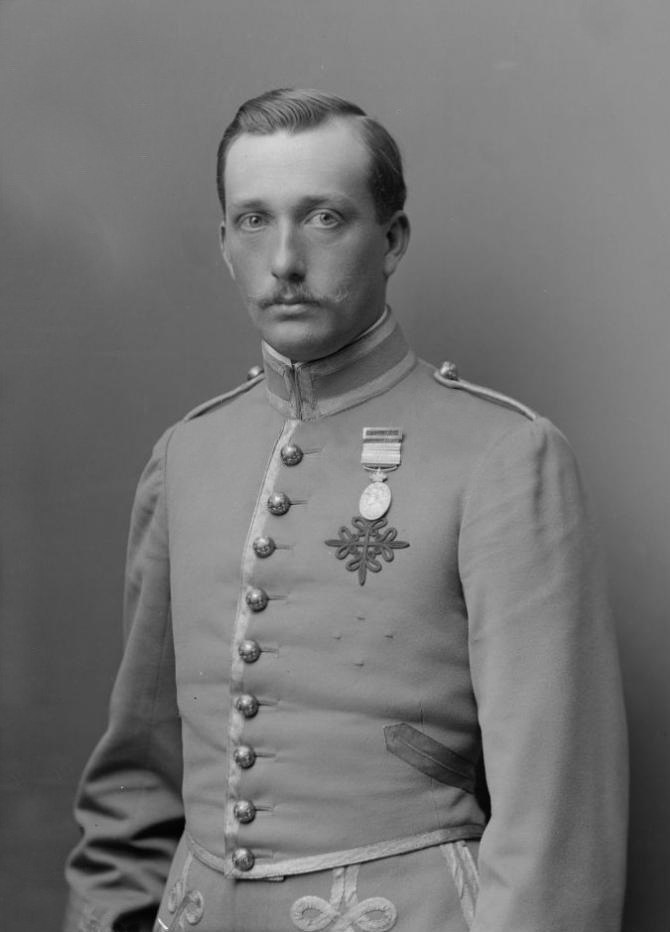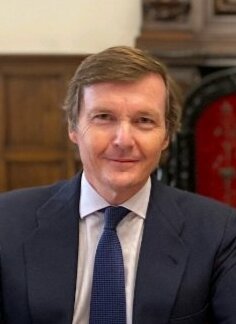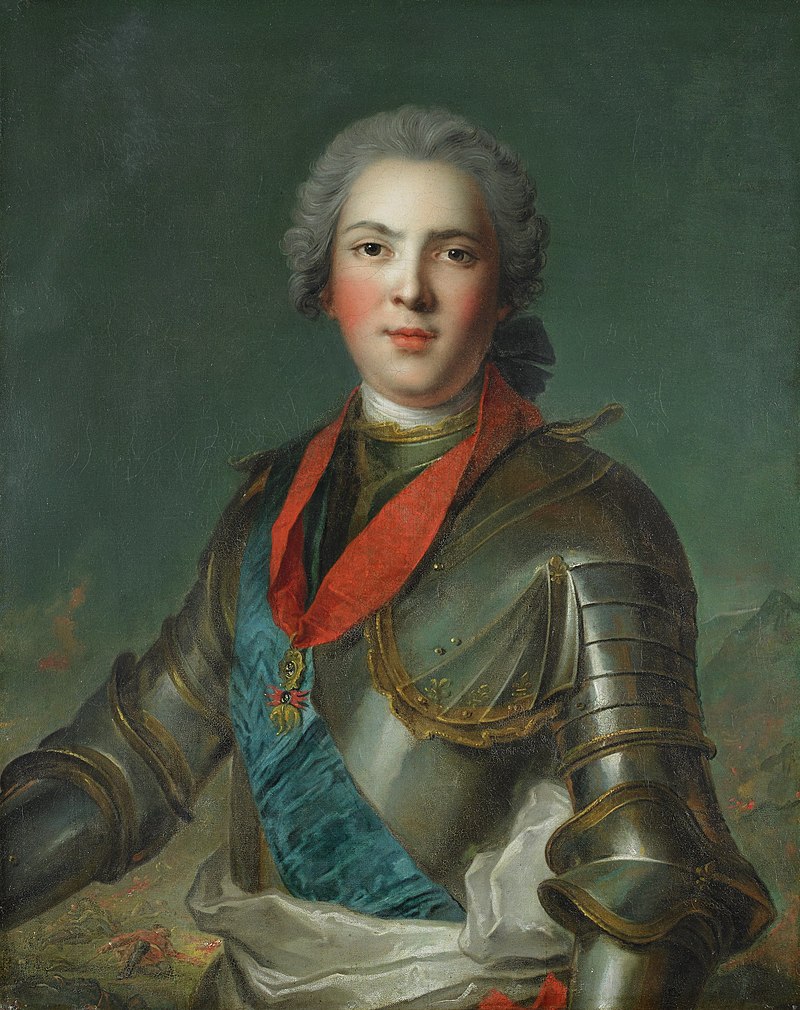by Susan Flantzer
© Unofficial Royalty 2023

Prince Nicholas Romanov; Credit – www.nashagazeta.ch
Prince Nicholas Romanov, a great-great-grandson of Nicholas I, Emperor of All Russia, was one of the disputed pretenders to the Headship of the Russian Imperial Family from 1992 – 2014. The Headship of the Russian Imperial Family and succession to the former Russian throne has been in dispute, mainly due to disagreements over whether marriages in the Romanov family were equal marriages – a marriage between a Romanov dynast and a member of a royal or sovereign house.
The line from Nicholas I, Emperor of All Russia to Nicholas and his brother Dimitri who succeeded Nicholas in his claim: Nicholas I, Emperor of All Russia → Grand Duke Nicholas Nikolaevich of Russia → Grand Duke Peter Nikolaevich of Russia → Prince Roman Petrovich of Russia → brothers Prince Nicholas Romanov and Prince Dimitri Romanov
Born on September 26, 1922, at the villa of his grandfather Grand Duke Peter Nikolaevich of Russia in Cap d’Antibes, France, where his parents were in exile, Nicholas Romanovich Romanov was the elder of the two children and the elder of the two sons of Prince Roman Petrovich of Russia, a great-grandson of Nicholas I, Emperor of All Russia, and Countess Praskovia Sheremeteva, a member of the House of Sheremeteva, one of the wealthiest and most influential Russian noble families. Nicholas’ paternal grandparents were Grand Duke Peter Nikolaevich of Russia and Princess Milica of Montenegro, daughter of King Nikola I of Montenegro. His maternal grandparents were Count Dmitry Sergeevich Sheremetev and Countess Irina Illarionovna Vorontsova-Dashkova.

Prince Roman Petrovich, his wife Praskovia holding Dmitri, and Nicholas; Credit – Time Note
Nicholas had one younger brother:
Nicholas spent the early years of his life in Antibes, France, where his family employed a Russian staff and a Russian nanny for Nicholas and his brother. The family used the Julian calendar and spoke Russian and French. Nicholas received a traditional Russian education, following the old Russian school curriculum. He later said that as a child, everything around him was so Russian that he did not realize he was living in France and not Russia until he was six years old. In 1936, his family moved to Italy, where Nicholas attended the Humanitarian Academy in Rome, and the family lived at the Quirinal Palace in Rome with Vittorio Emanuele III, King of Italy and his wife Elena of Montenegro, Queen of Italy, who was the sister of Nicholas’ paternal grandmother Princess Milica of Montenegro. After the Italian monarchy was abolished in 1946, Nicholas’ family left for Egypt, where Nicholas was involved in the purchasing and sale of Turkish tobacco. In 1950, Nicholas returned to Italy and worked in Rome for the Austin Motor Company until 1954.
In 1950, Nicholas became acquainted with Countess Sveva della Gherardesca, the daughter of Count Walfred della Gherardesca and Nicoletta de Piccolellis, from the noble Tuscan family, the House della Gherardesca. Nicholas and Sveva were married in a civil ceremony in Florence, Italy on December 31, 1951, and in a Russian Orthodox ceremony at the Church of the St. Michael the Archangel in Cannes, France on January 21, 1952.
Nicholas and Sveva had three daughters:
- Princess Natalia Nikolaevna Romanova (1952), married Giuseppe Consolo (link in Italian), an Italian politician, had one son and one daughter Nicoletta Romanoff, an Italian actress
- Princess Elisaveta Nikolaevna Romanova (born 1956), married Mauro Bonacini, had one son and one daughter
- Princess Tatiana Nikolaevna Romanova (born 1961), married (1) Giambattista Alessandri, no children, divorced (2) Giancarlo Tirotti, had one daughter
Following the death of his wife’s brother, Nicholas managed his wife’s property and business in Tuscany, Italy, a large farm that bred cattle and produced wine. The farm was sold in 1982 and Nicholas and Sveva moved to Rougemont, Switzerland where they lived for part of the year and lived in Italy with their daughters for the other part of the year. Nicholas was a stateless person, a refugee from birth, and traveled on a letter issued by the King of Greece. He finally became a citizen of Italy in 1988. Nicholas visited Russia for the first time in June 1992 when he acted as a tour guide for a group of businessmen.
Prince Vsevolod Ioannovich, Nicholas’ father Prince Roman Petrovich, and Prince Andrei Alexandrovich, the heads of the Konstantinovichi, Nikolaevichi, and Mihailovichi branches of the Russian Imperial Family came up with the idea of a family association of the Romanovs. The association’s purpose would be to strengthen the links between the family and protect it from impostors. Some preliminary work had been done but the association had not yet been created when Prince Roman Petrovich died in 1978. After looking through his father’s papers, Nicholas found that everything was in place to create the Romanov Family Association. In 1979, the Romanov Family Association was officially formed with Prince Dmitri Alexandrovich (a grandson of Alexander III, Emperor of All Russia and the son of Grand Duke Alexander Mikhailovich of Russia and Grand Duchess Xenia Alexandrovna of Russia, the sister of Nicholas II, Emperor of All Russia) as president and Prince Nicholas Romanov as vice-president. When Prince Dmitri Alexandrovich died in 1980, his younger brother Prince Vasili Alexandrovich became president and Nicholas remained vice president. In 1989, after the death of Vasili Alexandrovich, Nicholas was elected the president of the Romanov Family Association. The majority of male-line descendants of Emperor Nicholas I of Russia are members of the Romanov Family Association.
In 1924, after Grand Duke Michael Alexandrovich (son of Alexander III, Emperor of All Russia and brother of Nicholas II, Emperor of All Russia) whose body has never been found, was declared legally dead, Grand Duke Kirill Vladimirovich of Russia, a male-line grandson of Alexander II, Emperor of All Russia, declared himself Guardian of the Throne and later assumed the title Emperor of All Russia. Upon the death of Grand Duke Kirill Vladimirovich in 1938, his son Grand Duke Vladimir Kirillovich was recognized as the Head of the Russian Imperial House by the Grand Dukes and Princes of Imperial Blood behind him in order of dynastic seniority and by the majority of the reigning houses of Europe.
The Romanov Family Association’s official position is that the rights of the family to the Russian throne were suspended when Nicholas II, Emperor of All Russia abdicated for himself and for his son Tsarevich Alexei in favor of his brother Grand Duke Michael Alexandrovich. Michael declined to accept the throne unless the people were allowed to vote for the continuation of the monarchy or the creation of a republic. Of course, that vote never happened. Emperor Michael II, as he was legally pronounced by Nicholas II, did not abdicate but empowered the Provisional Government to rule. Michael’s “reign” did not end until his execution in 1918.
After the Russian Revolution, surviving members of the House of Romanov were in exile and settled in Europe with close or distant relatives. Because of their situation, many male Romanovs were unable to choose a spouse from European sovereign houses, and married women from noble and famous Russian families – Kurakins, Orlovs, Chavchavadze, Sheremetevs, Vorontsov-Dashkovs, Kutuzovs, Golitsyns. Regarding unequal marriages, Prince Nicholas Romanov said, “Our parents married commoners. So what? We have married commoners. Again, so what? There was nobody to ask us to renounce our rights, so we married without renouncing them, and we and our children still have rights to the throne of Russia.”
The headship of the House of Romanov has been contested since the death of the last undisputed male dynast Grand Duke Vladimir Kirillovich of Russia in 1992. Upon his death, competing claims over the headship of the House of Romanov emerged between Prince Nicholas Romanov and Grand Duke Vladimir’s daughter Grand Duchess Maria Vladimirovna. Prince Nicholas’ claim was based on a 1911 Ukase issued by Nicholas II, Emperor of All Russia that the equal marriage rule applied only to Grand Dukes (the sons and grandsons of an emperor) and that princes (the great-grandsons onward of an emperor) could marry women of “good standing” for their marriage to be dynastic and therefore transmit succession and dynastic rights to their children, and that women, namely Maria Vladimirovna, could succeed only on the total extinction of the male line. The Romanov Family Association recognized Prince Nicholas Romanov as the senior male dynastic representative and head of the family on December 31, 1992, in Paris, France and this was symbolically re-confirmed on Russian soil after the state burial of Emperor Nicholas II and his family in 1998. The Romanov Family Association further stated that they consider the marriage of Maria Vladimirovna’s parents unequal.
Pre-revolutionary Romanov house law allowed only those born of an equal marriage between a Romanov dynast and a member of a royal or sovereign house to be in the line of succession to the Russian throne. The throne could only pass to a female and through the female line upon the extinction of all legitimately-born, male dynasts. Maria Vladimiovna’s mother Princess Leonida of Bagration belonged to a family that had been kings in Georgia from medieval times until the early 19th century. However, no male line ancestor of Leonida had reigned as a king in Georgia since 1505 and her branch of the Bagrations, the House of Mukhrani, had been naturalized as non-ruling nobility of Russia after Georgia was annexed to the Russian empire in 1801. There is a precedent that a marriage between the House of Romanov and the House of Bragation-Mukhrani was unequal. The House of Bragation-Mukhrani did not possess sovereign status and was not recognized as equal by Nicholas II, Emperor of All Russia for the purpose of dynastic marriages at the time of the marriage of Princess Tatiana Konstantinovna of Russia and Prince Konstantine Bragation-Mukhrani in 1911, thirty-seven years before the marriage of Princess Leonida of Bragation-Mukhrani and Grand Duke Vladimir Kirillovich of Russia. The couple married but Princess Tatiana Konstantinovna was required to renounce her rights to the Russian throne and was no longer a member of the House of Romanov because the marriage was unequal.
Prince Nicholas Romanov did not act for the restoration of the monarchy or engage in dynastic activities such as the distribution of Russian imperial titles and orders. Maria Vladimirovna claims the status of de jure Empress of All Russia, styles herself as Grand Duchess and her son George Mikhailovich as Grand Duke and Tsesarevich, the title for the heir apparent, and actively distributes Russian imperial orders, all of which have been condemned by the Romanov Family Association.
After the discovery and identification of the remains of Nicholas II, Emperor of All Russia, his family, and the servants who were killed with the family, Maria Vladimirovna proposed the remains be divided into three groups – Nicholas II and his wife Alexandra Feodorovna be interred at the Peter and Paul Cathedral in St. Petersburg, Russia, the traditional Romanov burial site, the three daughters who were identified be interred at the Grand Ducal Mausoleum located on the left side of the Peter and Paul Cathedral, and the servants be interred in Ekaterinburg, Russia where the murders occurred. (Note: The remains of Tsesarevich Alexei and his sister Grand Duchess Maria were discovered in 2007, and were positively identified in 2009. However, the remains of Alexei and Maria have not yet been buried. The Russian Orthodox Church has questioned whether the remains are authentic and blocked the burial.
This proposal shocked Prince Nicholas Romanov and the other members of the Romanov Family Association. Their original position was to bury all the remains together in Ekaterinburg, Russia. Prince Nicholas stated the Romanov Family Association’s position: “We Romanovs want everybody, every victim of that massacre, to be buried together, in the same place, in the same cathedral, and, I’d say, in the same tomb. You want to bury the tsar in the Peter and Paul Fortress cathedral? Good! Then bury the doctor, the maid, and the cook with them, in the tsar’s mausoleum. They have been lying together for seventy-three years. They are the only ones who never betrayed the family. They deserve to be honored at the same time, in the same place.”
Prince Nicholas Romanov led the Romanov family at the formal burial of Nicholas II, Emperor of All Russia, his wife Empress Alexandra Feodorovna, their daughters Grand Duchesses Olga, Tatiana, and Anastasia, their physician Dr. Eugene Botkin, their cook Ivan Mikhailovich Kharitonov, their footman Alexei Yegorovich Trupp, and their maid Anna Stepanovna Demidova on July 17, 1998, the 80th anniversary of their deaths, in St. Catherine Chapel at the Peter and Paul Cathedral in Saint Petersburg, Russia. Because, at the time, the Russian Orthodox Church did not recognize the authenticity of the remains, Maria Vladimirovna did not attend the formal burial. However, the Russian government’s refusal to recognize her status as the official Head of the Romanov House is also given as a reason.
Prince Dmitri Romanov (left) and Prince Nicholas Romanov (second left) stand at the tomb of Empress Maria Feodorovna during a burial ceremony in the royal crypt at the Cathedral of the Peter and Paul Fortress in St. Petersburg on September 28, 2006
Prince Nicholas and his brother Prince Dmitri lobbied Queen Margrethe II of Denmark and President Vladimir Putin of Russia to allow the transfer of the remains of Empress Maria Feodorovna, born Princess Dagmar of Denmark, from Denmark to Russia so she could be buried alongside her husband Alexander III, Emperor of All Russia. Nicholas and Dmitri were both present on September 28, 2006, at a service for Empress Maria Feodorovna at Saint Isaac’s Cathedral and then at the Peter and Paul Cathedral, both in St. Petersburg, where she was interred next to her husband Emperor Alexander III.
Prince Nicholas Romanov died on September 15, 2014, eleven days before his 92nd birthday, in Bolgheri, Tuscany, Italy. His funeral was held on September 17, 2014, at the Church of Saints Jacob and Christopher in Bolgheri, Tuscany, Italy. He was interred in the crypt of the Counts della Gherardesoc, the burial site of his wife’s family, at the Basilica of Saint Francis in Pisa, Tuscany, Italy.
This article is the intellectual property of Unofficial Royalty and is NOT TO BE COPIED, EDITED, OR POSTED IN ANY FORM ON ANOTHER WEBSITE under any circumstances. It is permissible to use a link that directs to Unofficial Royalty.
Works Cited
- Massie, Robert K. (1995) The Romanovs: The Final Chapter. New York: Random House
- Nicholas Romanov, Prince of Russia (2021) Wikipedia. Available at: https://en.wikipedia.org/wiki/Nicholas_Romanov,_Prince_of_Russia (Accessed: 10 August 2023).
- Prince Nicholas Romanov – Obituary (2014) The Telegraph. Available at: https://www.telegraph.co.uk/news/obituaries/11121560/Prince-Nicholas-Romanov-obituary.html (Accessed: 10 August 2023).
- Prince Roman Petrovich of Russia (2023) Wikipedia. Available at: https://en.wikipedia.org/wiki/Prince_Roman_Petrovich_of_Russia (Accessed: 10 August 2023).
- Романов, Николай Романович (2023) Wikipedia (Russian). Available at: https://ru.wikipedia.org/wiki/%D0%A0%D0%BE%D0%BC%D0%B0%D0%BD%D0%BE%D0%B2,_%D0%9D%D0%B8%D0%BA%D0%BE%D0%BB%D0%B0%D0%B9_%D0%A0%D0%BE%D0%BC%D0%B0%D0%BD%D0%BE%D0%B2%D0%B8%D1%87 (Accessed: 10 August 2023).
- Романов, Роман Петрович (2023) Wikipedia (Russian). Available at: https://ru.wikipedia.org/wiki/%D0%A0%D0%BE%D0%BC%D0%B0%D0%BD%D0%BE%D0%B2,_%D0%A0%D0%BE%D0%BC%D0%B0%D0%BD_%D0%9F%D0%B5%D1%82%D1%80%D0%BE%D0%B2%D0%B8%D1%87 (Accessed: 10 August 2023).
- The Romanov Family Association. Available at: http://www.romanovfamily.org/index.html (Accessed: 10 August 2023).





































